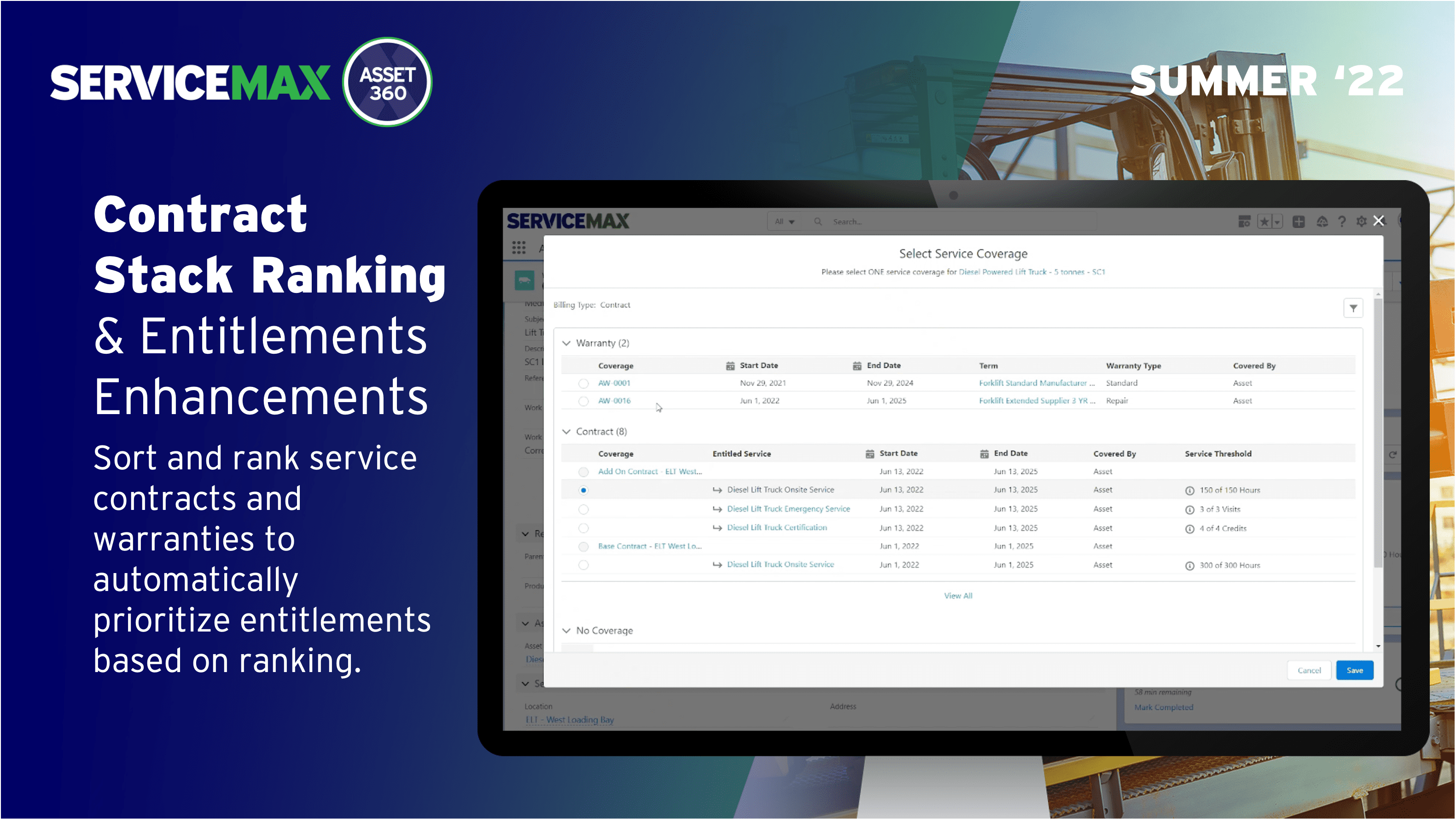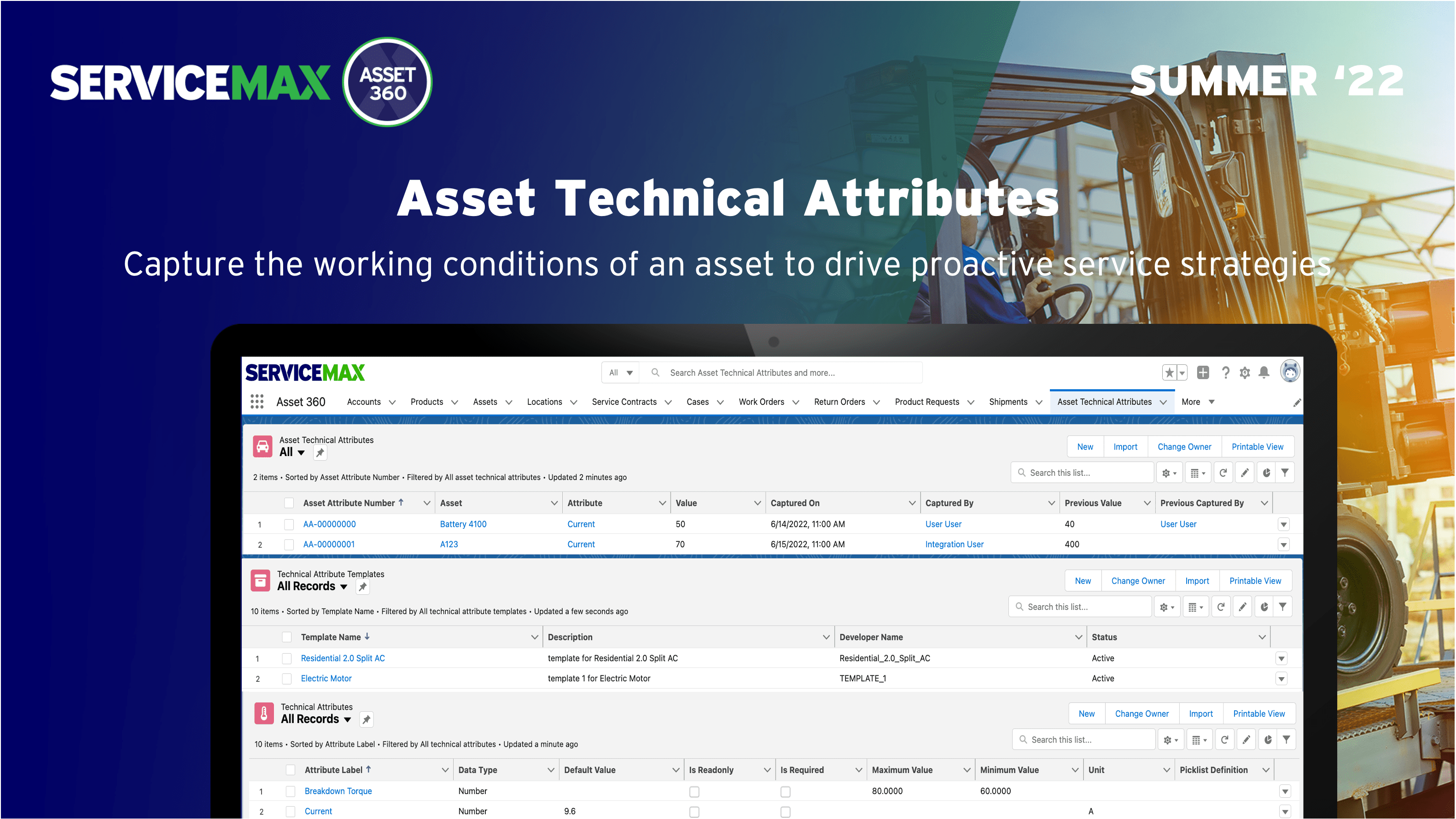The Summer ’22 release of Asset 360 was released Friday, July 1. In this release, we’re introducing new features around entitlements, asset data, and installed base visualization, reinforcing the key strengths of Asset 360 while taking steps into new areas.
In this post, we’ll highlight 3 major features of this release. For a full list of the enhancements and features in Asset 360 Summer ’22, refer to the release notes.
Entitlements – Contract Stack Ranking
In this release, we are expanding what’s possible with entitlement, with Contract Stack Ranking, enhancements to the Entitlement Engine, and UX enhancements to increase the flexibility and intelligence of entitlements, for all personas.
Contract and entitlement management are critical functional areas of Asset 360. Since the launch of Asset 360, we’ve introduced several features around entitlements and contract management that add flexibility, nuance, and automation to help our customers accurately map to the multifaceted nature of contract management and entitlement verification.
For any high-value, complex asset, it is entirely possible that conflicting contracts and warranties apply, making managing entitlements on the customer account and asset-level a tricky and time-consuming process. A customer might have signed a global service contract with one set of terms, own multiple assets purchased at different times with different warranties, and different regions/business units might have set up individual contracts. And if an asset has been under contract for a long time, it is also entirely possible to have individual warranties for replaced parts.
In Summer ’22, we’re introducing a new feature, Contract Stack Ranking, to provide a way for our customers to prioritize against conflicting coverages and influence the order in which services are consumed.

With Contract Stack Ranking, service organizations can introduce a method of ranking for service contracts. This allows front-line service teams, dispatchers, technicians, contract managers, or back office managers to get visibility on what coverages are available as well as the order in which the service organization may want these services to be consumed.
Contract Stack Ranking introduces additional flexibility for our customers to manage complex contracts, warranties, and entitlements at scale. From service contract authoring, connections to CPQ, to contract management and tracking, we continue to enhance this product area to help our customers meet commitments and SLAs, prevent leakage, provide visibility across the asset service lifecycle, and grow service revenue.
Asset Data – Asset Technical Attributes
Our customers manufacture and service high-value, complex equipment such as MRI machines, printers, diagnostic equipment, oil rigs, electrical transformers – and maintaining visibility into the installed base is a crucial aspect of their business.
While Salesforce focuses on customer data, ServiceMax’s asset-centric field service management solution streamlines the complexities of service operations by delivering a complete 360-degree view into assets. This asset-centric strategy enables our customers to drive operating margins, maximize revenue, and increase the lifetime value of the asset.
With visibility into asset data, all parts of the organization benefit and make critical decisions based on data. Service delivery teams can access and understand commitments and make quick decisions to resolve customer issues, providing a better customer experience. Commercial teams such as sales and account management are provided with a view of how products and services are used, can articulate the value of the relationship, driving customer retention, upsells, and renewals. Service leaders, finance, and those responsible for strategic decisions can leverage metrics and dashboards to inject agility and data-driven decision-making into the organization.
In Summer ’22, we introduced a new data model for Asset Technical Attributes. This allows for the capture of the working conditions of an asset, such as usage, asset operating conditions, output, and more.

With Asset Technical Attributes, OEMs are able to create a unique set of technical fields for every asset, and in future releases, these fields can be populated manually by technicians, end customers, call center agents, or even automatically via IoT integrations.
Installed Base Visualization – Asset Attach Rate
Related to asset data, Asset 360 helps customers visualize asset data in an intuitive, actionable way. The Summer ’22 release includes Asset Attach Rate, a new dashboard powered by CRM Analytics (previously Tableau CRM).

The Asset Attach Rate dashboard shows an account-level view of the installed base, including assets under contract, assets under warranty, and assets with no coverage. For service leaders and account managers, this provides an actionable view of the attach rate and revenue opportunity within an account’s installed base.
The CRM Analytics package of dashboards is available today in beta and includes Cost-to-Serve Analytics, Service Profitability, Asset Location Insights, and with this release, Asset Attach Rate.
Learn More About the Asset 360 Summer ’22 Release
In addition to the above, this release includes enhancements to SPM, Asset Hierarchy, Asset Timeline, and more. Watch the Asset 360 Summer ’22 Product Release On-Demand where product marketing and product management discuss the highlights of this release. For a full list of the enhancements and features in Asset 360 Summer ’22, refer to the release notes.


Share this: